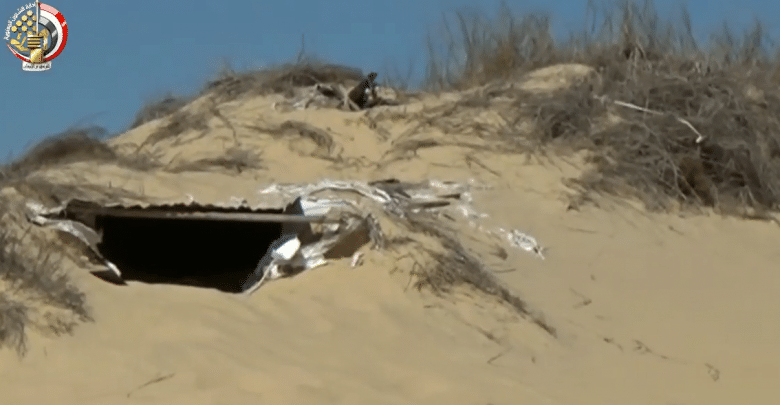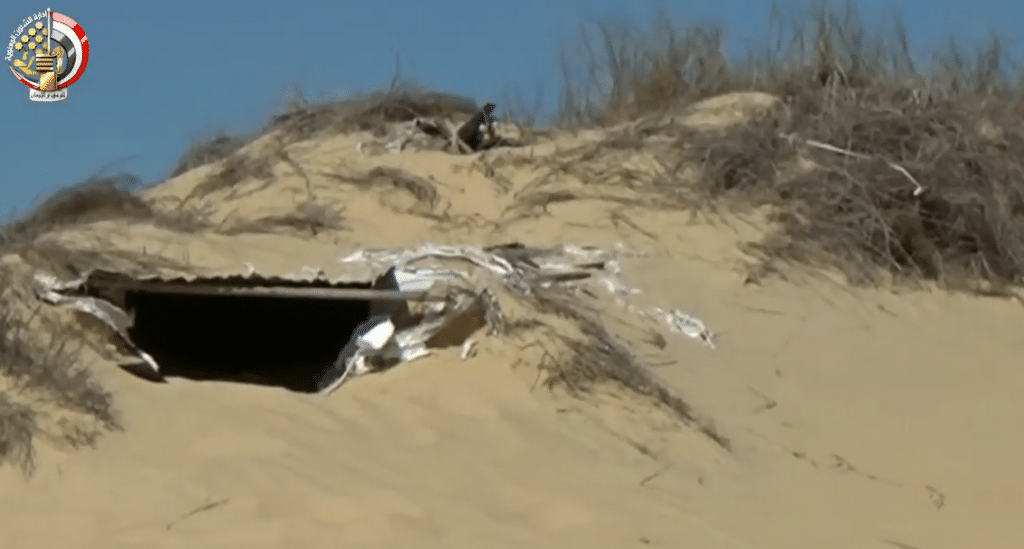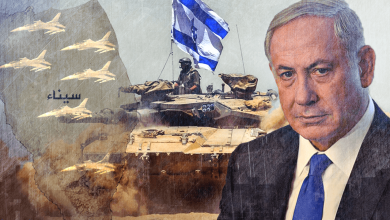
Development of the military situation in Sinai Nov
In November 2019, an official decision was issued to appoint some tribal sheikhs in North Sinai Governorate. The appointments come at a time when residents of the governorate suffer from deteriorating economic conditions due to the economic embargo imposed by the army and security forces on some goods and professions, which led to suspension of many commercial activities such as shops selling car tires; and fishermen continued to suffer in the city of El-Arish, despite the launch of a popular campaign in solidarity with them.
During this month, Abdel Fattah al-Sisi opened the old Suez Canal tunnels to connect the two banks of the canal, which is considered a very important economic step if it comes in the context of a national development policy. However, there are fears that the economic projects carried out in the Sinai Peninsula, including delivery of the Nile water for the first time in October, come within the framework of the political deal of the century that aims to end the Palestinian cause by imposing a certain political and economic reality with some minimal gains.
On the other side, the Islamic State’s local organization, known as Sinai Province, renewed its pledge of allegiance to the organization and its new leader, to be the first IS branch to do so.
The IS branch in Sinai managed to absorb the intense military strikes it received during 2018 in addition to its suffering resulting from the collapse of the parent organization (in Syria and Iraq). Since the second half of 2019, the militant organization has maintained a steady pace of attacks in addition to its presence in new areas, such as the area to the east of Bir al-Abed.
On the other hand, it appears that the Egyptian regime’s fears are increasing on likeliness of the militant organization’s implementations of effective attacks against tourist areas in South Sinai, which prompted it to further strengthen security measures, including the construction of a concrete wall equipped with CCTV devices and watch points along 37 kilometers around the city of Sharm El-Sheikh.
In this report, we will review the course of military and security operations during November in the Sinai Peninsula, as follows:
Military and security developments
The following graph shows a comparison between the military losses of the two conflicting parties during the last six months, according to sources from both parties as well as the monitoring of the Egyptian Institute of Studies:

First: Casualties and losses as declared by the Army and militants
Following are the casualties and losses during November 2019 disseminated through the Egyptian Army communiques and the statements declared by militants as well as media reports:
1- Casualties and losses as declared by the military spokesman and the Egyptian Interior Ministry
During November, the military spokesman issued only one military statement related to the military operations that took place in the Sinai Peninsula during the period from September 28, 2019 to November 4, 2019; and the statement stated that the Egyptian Air Force targeted and destroyed 14 hideouts and shelters, and 9 four-wheel drive vehicles, killing 77 people, described by the statement as “Takfiris”. The army forces, according to the statement seized 65 weapons, 78 cartridges, 20 mortar bulbs, a quantity of ammunition, explosive devices intended for detonation, solar energy units and communication devices which were found in their possession in North and Central Sinai. The attack resulted in the killing of 6 people, described as “extremely dangerous Takfiris”. The statement also announced discovery and detonation 376 IEDs, detection and destruction of two tunnel openings, seizing and destroying thirty-three vehicles and 93 motorcycles without metal plates, allegedly used by armed elements, and arresting 61 wanted ‘criminals’ and suspects.
The figures in the above graph, comparing losses of the army, police and militants, includes the total losses of militants, according to the statement of the armed forces covering the period from September 28 to November 4.

A picture of some ammunition and equipment found by the army in fields of operations in Sinai, according to the statement of the military spokesman
2- Casualties and losses as declared by militants and media report:
According to what was monitored by the Egyptian Institute for Political and Strategic Studies in November, the casualties and losses of the army and police forces were as follows:
– At least 11 military personnel were killed, including at least 4 officers; and 18 others were injured.
– We also noticed intensive activity by IS militants in the vicinity of Al-Jandal village, east of Bir al-Abed, in addition to its ongoing activity in the east, west, and south of Sheikh Zuwaid, west of Rafah, and west of El Arish. During the month, we monitored the IS local affiliate organization’s targeting of a foot patrol with two rocket-propelled grenades, and use of 14 anti-armor explosive devices, resulting in the destruction / damage of at least 14 military vehicles.
Second: Overview of the developments of the military campaign in Sinai Peninsula
Following is an overview of the developments of the military operations in Sinai Peninsula during November 2019:
November witnessed continuation of various attacks by the Sinai Province in several regions (Rafah, Sheikh Zuwaid, El Arish, Bir al-Abed), and according to our monitoring of the organization’s attacks, there is an increased presence in the east of Bir al-Abed since June 2019. The IS militants were capable of infiltration and presence in the vicinity of Al-Jandal village, planting explosive devices and targeting tanks belonging to the Egyptian army. However, the local residents fear that the military leadership of the Egyptian army may take advantage of these conditions and carry out forced displacement and evictions of residents, with demolition of homes and razing of farms in the east of Bir Al-Abed.
Our assessment and observations on the developments in the military scene this month were as follows:
1- There was less than average frequency of field military operations, with a varied activity of IS militants in the following areas:
– At least 3 attacks in west of Rafah.
– At least 2 attacks in west of Sheikh Zuwaid.
– At least one attack in east of Sheikh Zuwaid.
– At least one attack in west of El-Arish.
– At least 4 attacks in east of Bir al-Abed.
2- The militant organization relied in most of its attacks this month on planting explosive devices and detonating them from a distance, avoiding armed clashes that may lead to loss of some of its personnel.
3- Continued active presence of the militant organization in the east of the city of Bir al-Abed. Despite the intensive military operations launched by the army in the traditional areas of the presence of the militant organization in Rafah and Sheikh Zuwaid, the organization kept active personnel that were able to plant explosive devices and carrying out attacks in these areas.
4- The army forces are keeping a tight lid on their casualties, and had it not been for the reports on funerals of some of army recruits in some newspapers or social networking sites, we would not have been able to identify some of these casualties.
5- The Egyptian warplanes continued to carry out air strikes against the eastern areas of the city of Bir al-Abed, but at a very low rate. We also noticed that drones carried out more than two air strikes in the areas of Sheikh Zuwaid and Rafah against unknown targets, after militant attacks against vehicles of the army forces.
6- Calm prevailed in the city of El-Arish, as no activity by the militants was monitored during this month; as it appears that the organization does not want to expose security of any of its cells inside the city to danger except in successful well-planned attacks.
7- The pictures included in the statement of the military spokesperson of the Egyptian Armed show that, during the period from September 28 to November 4, the army forces were able to access some of the militant organization’s residence in the desert in addition to places the organization’s militants use to store their weapons; and the statement also shows that the army killed some militants. But on the other side, other pictures still show the army’s policy of liquidating numbers of the arrested and forcibly disappeared citizens for suspicion of relation to the Islamic State; where more than one picture showed presence of corpses machine guns without cartridges placed next to them.

A picture shows a hideout used by IS militants in Sinai, according to the statement of the military spokesman
Third: Israeli drone attacks and violation of sovereignty
We did not monitor any raids by the “Israeli” air forces during this month, but we monitored at least several air strikes from warplanes targeting unknown targets inside agricultural lands south of the city of El-Arish on November 6. We also detected drone attacks on November 6 and 9 targeting areas south of Sheikh Zuwaid and south of Rafah, and in the vicinity of the Shabana village. The strikes came as a response to attacks that targeted some vehicles of the Egyptian army forces in both areas.
It is noteworthy that intervention of “Israeli” drones in Sinai has been taking place on a regular basis since 2011, but Egypt has started to pay attention to the use of drones in Sinai since 2016.
To read the PDF click here
To Read Text in PDF Format Click here.



